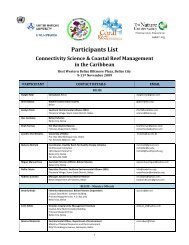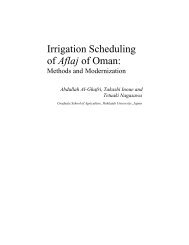The Global Water Crisis: Addressing an Urgent Security - Unu-inweh ...
The Global Water Crisis: Addressing an Urgent Security - Unu-inweh ...
The Global Water Crisis: Addressing an Urgent Security - Unu-inweh ...
Create successful ePaper yourself
Turn your PDF publications into a flip-book with our unique Google optimized e-Paper software.
4. <strong>Water</strong> Policies <strong>an</strong>d <strong>The</strong>ir Impact in Indigenous Territories<br />
Neo-liberal policies in Latin America brought about the exploitation of mineral resources, the production of exportation<br />
crops, the building of communications <strong>an</strong>d hydraulic infrastructure, <strong>an</strong>d the exp<strong>an</strong>sion of urb<strong>an</strong> settlements. Because of<br />
these developments, the defense of territory <strong>an</strong>d natural resources became central dem<strong>an</strong>ds to the indigenous movement<br />
(Gentes, 2009). <strong>The</strong> lack of acknowledgment of indigenous territories by the state <strong>an</strong>d the fragmentation of rights linked<br />
to l<strong>an</strong>d <strong>an</strong>d water favoured pillage <strong>an</strong>d dispossession in the absence of <strong>an</strong> inclusive norm. This is due to the indigenous<br />
conception of territory as including all associated natural resources such as l<strong>an</strong>d, water, wetl<strong>an</strong>ds, forests <strong>an</strong>d grassl<strong>an</strong>ds;<br />
in contrast, the legal conception of l<strong>an</strong>d by the state disarticulates these elements in different l<strong>an</strong>d tenure regimes <strong>an</strong>d<br />
through licenses given to individuals.<br />
During the 1980s <strong>an</strong>d 1990s, Latin Americ<strong>an</strong> states made structural reforms to give impetus to <strong>an</strong> economic model<br />
based on free-market principles, with a domin<strong>an</strong>t participation of the private sector in strategic areas of the economy<br />
<strong>an</strong>d corresponding accord<strong>an</strong>ce of legal certitude of private property of natural resources, such as l<strong>an</strong>d <strong>an</strong>d water. To<br />
give susten<strong>an</strong>ce to the implemented national public policies, ch<strong>an</strong>ges were made to the relev<strong>an</strong>t legal <strong>an</strong>d institutional<br />
frameworks. <strong>The</strong> implications of these legal reforms in the territories of indigenous people have led to fragmentation<br />
<strong>an</strong>d to the private benefit ownership – not by local people – of common goods that are nevertheless part of their l<strong>an</strong>dwater-forest<br />
socio-cultural matrix.<br />
5. Conflicts for Access to <strong>Water</strong> in Indigenous Peoples’ Territories in<br />
Latin America<br />
In the presence of the const<strong>an</strong>t violation by states of hum<strong>an</strong> <strong>an</strong>d indigenous peoples’ rights, the scenario of social conflict<br />
for water is intense <strong>an</strong>d complex in the Latin Americ<strong>an</strong> region. <strong>The</strong>se circumst<strong>an</strong>ces have been worsened by structural<br />
reforms that have led to a decreased role of states, which are expressed through more flexible legal <strong>an</strong>d normative<br />
frameworks that favour the ascension of the private sector to a prominent role, <strong>an</strong>d in increased incentives for private<br />
investments in strategic areas such as energy, water, mining <strong>an</strong>d urb<strong>an</strong>ization.<br />
M<strong>an</strong>y of the conflicts occurring at present fall within such a category <strong>an</strong>d are not necessarily the result of a water crisis <strong>an</strong>d<br />
its ‘feared wars’. Rather, they are <strong>an</strong> expression of omissions <strong>an</strong>d direct actions of the state <strong>an</strong>d of other actors or economic<br />
stakeholders that have made vulnerable the essential rights of the poorest <strong>an</strong>d marginal sectors of the population: the<br />
indigenous peoples (Boelens et al., 2006).<br />
<strong>The</strong>refore, in the last 15 years a variety of conflicts over water in the indigenous regions of Latin America have emerged,<br />
which demonstrate a tension due to the modification of rights (both recognized <strong>an</strong>d unrecognized) over the control of<br />
territory <strong>an</strong>d the m<strong>an</strong>agement of natural resources, as well as negative social <strong>an</strong>d environmental impacts associated<br />
with public <strong>an</strong>d private investments undertaken to favour the domin<strong>an</strong>t economic model <strong>an</strong>d the urb<strong>an</strong>ization process.<br />
Among the socio-environmental conflicts connected with water access are those associated with: the exp<strong>an</strong>sion of mining<br />
in indigenous regions of North, Central <strong>an</strong>d South America (the Huichol, Nahua, <strong>an</strong>d Mixteca peoples in Mexico, Maya<br />
peoples in Guatemala, <strong>an</strong>d Ande<strong>an</strong> peoples in Peru); the privatization of water in Bolivia (indigenous peoples of Los Altos<br />
<strong>an</strong>d Cochabamba regions); the construction of hydroelectric dams in Brazil (the Amazoni<strong>an</strong> Kayapo peoples), Brazil-Bolivia<br />
(the Karit<strong>an</strong>a, Karipuna, Oro Bom, Cassupá, Salamai, Katawixi, Uru-eu-Wau-Wau peoples), Chile (Mapuche Pehuenche<br />
peoples), Ecuador (Afro-Ecuadore<strong>an</strong> peoples), <strong>an</strong>d P<strong>an</strong>ama (the Naso <strong>an</strong>d Ngöbe peoples); the construction of highways<br />
in Bolivia (Moxeño, Yuracaré, Chimán peoples); the supply of water from one watershed to <strong>an</strong>other for urb<strong>an</strong>ization<br />
purposes in Mexico (the Mazahua, Nahua, <strong>an</strong>d Yaqui peoples) <strong>an</strong>d Peru (peoples of the Hu<strong>an</strong>cavelica region); <strong>an</strong>d, the<br />
exp<strong>an</strong>sion of tourist projects in Mexico (the Maya, Purépecha, <strong>an</strong>d Nahua peoples).<br />
Access to <strong>Water</strong> <strong>an</strong>d Conflict: An Indigenous Perspective from Latin America<br />
Part 3<br />
145




